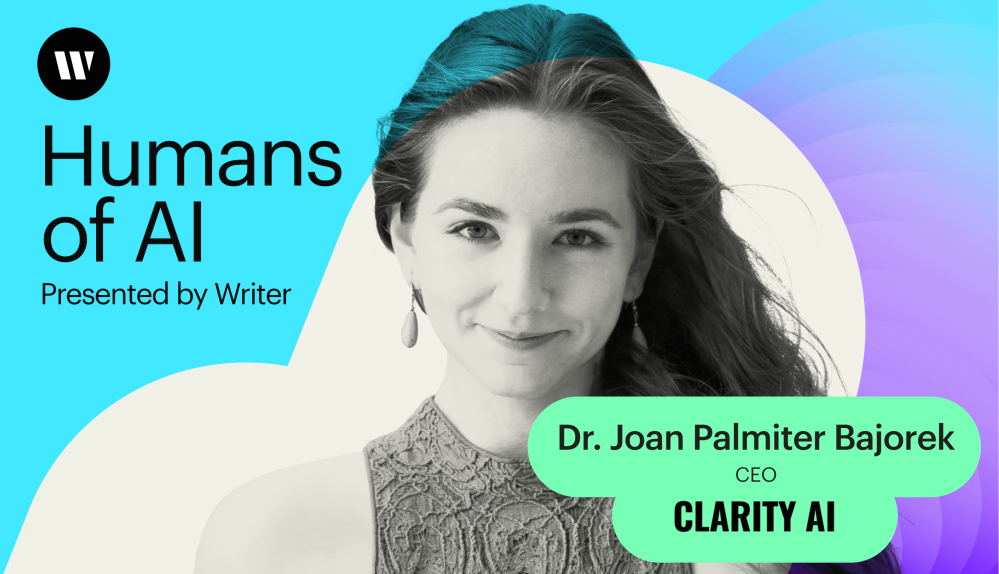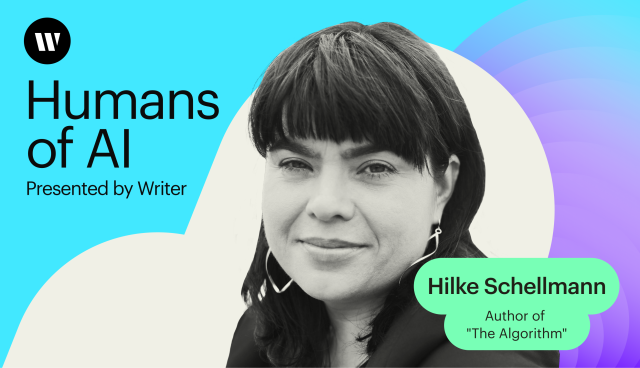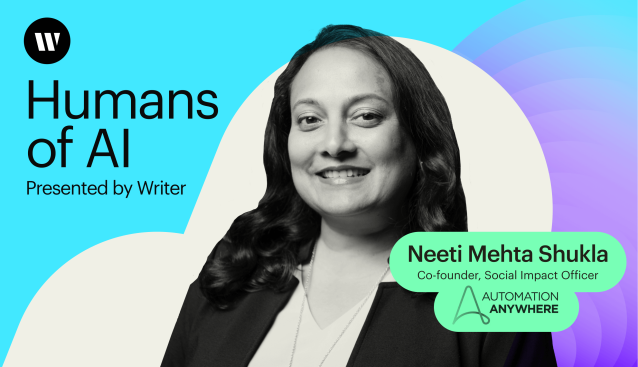Humans in the loop
– 7 min read
The power of finding your voice in the age of AI with Dr. Joan Palmiter Bajorek

The science and tech fields have long viewed a degree in the liberal arts as a one-way ticket to underemployment. But as the AI industry emerges, a background in the humanities will be essential to innovation in large language models and natural language processing, among other aspects of AI research and development.
In this episode of Humans of AI, we have a conversation with Dr. Joan Palmiter Bajorek, founder of Women in Voice and CEO of Clarity AI. As a linguist turned tech entrepreneur, Joan’s journey from the academic study of languages to the forefront of AI technology exemplifies the critical role that a humanities background can play in shaping the future of technology.
Joan points out that understanding the nuances of human language and communication is vital for creating AI that can interact effectively with humans. This is particularly important in the realm of voice AI, where the goal is to develop systems that can understand and respond to a wide range of human voices and dialects.
- As founder of Women in Voice and CEO of Clarity AI, Joan advocates for diversity and inclusivity in voice AI, highlighting the need for varied perspectives in technology creation.
- Joan’s background in linguistics and her experiences with language models inform her approach to AI, underscoring the importance of understanding human communication.
- Joan’s career journey illustrates the value of the humanities in tech, particularly how it equips professionals to innovate and lead in fields like AI.
- Joan envisions a future where AI enhances workplace efficiency and job satisfaction by automating mundane tasks, allowing humans to focus on more strategic and creative work.
The value of the humanities in AI
The humanities are academic disciplines that explore human society and culture — focusing on subjects like languages, arts, and philosophy. The humanities are often underestimated in the tech world, even though they provide deep insights into human behavior and communication — elements crucial to the success of AI applications. As a researcher and lingust by trade, Joan is a perfect example of how a foundation in the liberal arts can enrich AI development.
Joan’s career took a decisive turn when she encountered the language-learning platform Duolingo. As the platform began rolling out speech recognition features, she noticed that the app would tell her that her pronunciation was “correct,” even when it was far from it. This led her to question the human decisions behind the technology, and who was setting up the backend.
“I started doing research on the Duolingo teams, and it was like three dudes deciding what that benchmark is,” Joan explains. “But I was wondering, ‘What is this dataset? What is the visualization of the little speech thing?’”
This newfound interest in data matched with her passion for language and storytelling. Joan could transform data into compelling narratives that others in her graduate studies weren’t able to do as easily. Her master’s degree in linguistics correlated with Amazon’s release of the Echo, a smart speaker powered by its voice AI, Alexa. This pushed her further into the tech world.
Underrepresentation in voice AI
As Joan started presenting her linguistic research at tech events, she had a fish-out-of-water experience on two dimensions. She was often one of the only linguists and women in the room.
“When I went into tech environments, suddenly the demographics completely changed and it was kind of like a slap in the face or a punch in the stomach,” Joan recalls. “I definitely went to a whole warehouse where I don’t know if there was another woman in the entire building.”
Whoever is in the room gets to decide what’s getting built, and when everyone there has a homogeneous thought process, it results in products that don’t extrapolate to different demographics. Joan discusses these biases further in an article for Harvard Business Review, explaining how Google’s speech recognition might judge the accuracy of native English speakers differently depending on their race and gender.
When you consider the sensitivity of certain use cases for voice AI — like roadside assistance or surveillance — Joan stresses that the consequences of these biases can be very scary.
She felt as if she’d come to a fork in the road. She could either be complicit, or she could do something about it. Joan chose the latter.
Advocacy and impact through Women in Voice
Back when X was Twitter, Joan created the handle @WomenInVoice and put out a Google form for leadership roles. Within a few weeks, 20–30 people signed up, letting Joan know she wasn’t alone in her feelings of otherness and alienation.
Now, Women in Voice has expanded to over 20 chapters around the world. They’ve hosted over 300 global events, including their annual Women In Voice global summit that aims to honor, celebrate, and unite over 4,000 women and gender minorities working in voice technology. They also have a reward program to celebrate and amplify women in voice, speech, tech, and conversational AI.
Joan sees this coalition as a necessary step toward building well-made voice products, even if she had pushback from those around her at the beginning.
“I had an uncle tell me, ‘Don’t launch Women in Voice. You’re on the job market and working on your PhD, don’t do that.’ I disagreed,” Joan shares. “I really feel like for me, there’s a beacon on the horizon and I keep going towards it. Even if there are many pivots and kind of what that looks like are the words we use, I feel like my path feels very concrete for me.”
Practical applications of AI
Joan also founded Clarity AI, a firm which focuses on small and big ways to implement AI into your work and company. One of their missions is to focus on cutting through the fluff and hype to figure out what can actually be built.
This pragmatic approach is visible in a recent agriculture project she worked on. The client wanted to implement AI, but couldn’t pinpoint how to at first.
“He was like, ‘Just put AI on it.’ And I was like, ‘Okay, but what are we actually building? What is useful to you? What are some big pain points?’ And he said, ‘Water, if we could be more efficient with water.’ So then the conversation became about water efficiency and ‘How can we help you build your solution better to identify how to be efficient in water?’”
She’s also excited about the potential of AI in automation. Journey mapping is often one of the things she does with customers to pinpoint the most laborious and time-consuming tasks.
“One of the big and boring, but super practical projects we’ve done is when people were copying and pasting codes from different PDFs to different forms,” Joan says. “That was their day job. Two people all day long, just copying and pasting codes. I couldn’t believe people were still doing this. And they were like, ‘Can you please build us something to help this?’”
When AI systems automate repetitive work, it allows for organizational growth and a future-ready AI workplace. Through upskilling and reskilling, organizations can keep their employees engaged in meaningful work and equip them with the skills to adapt to new technologies.
Joan sees many opportunities and pivots for individuals that want to upskill or consider AI entrepreneurship. She regularly hosts webinars and teaches courses about careers in AI and AI startups.
Joan’s professional journey shows us how AI development requires an “all hands on deck” approach and why being a fish out of water is necessary to spearhead any real change. We need all different kinds of perspectives and voices to create AI systems that are truly effective and equitable. So, how do you plan to bring your own voice to the AI conversation?
Want to hear more stories from the humans working at the crossroads of business and generative AI? Subscribe to Humans of AI wherever you listen to podcasts.


